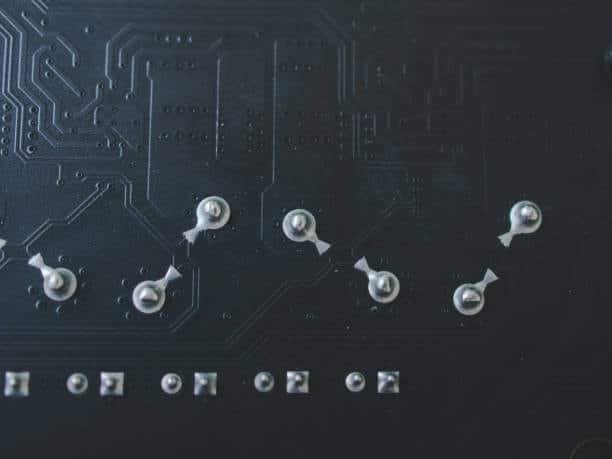Explore the various edge and applications of flux when using soldering iron by studying this useful guide. Know how apply soldering flux by its action to improve brazing performance and to augment powerful connections for numerous applications, including videos.
What is flux in soldering and how does it work?
Flux in brazing is specially designed to help ensure the solder extensively interfering with other alloys when the two surfaces are joined. It is available in a various forms, for example, as a liquid, paste or as a core apply within the solder material.
Its basic function is to scavenge or preclude oxide layers from forming on the metals surfaces under soldering. Oxides block the free construction of strong surface bonds, which can cause the defects eventually. Being susceptible to react with these oxides, either by dissolving them or by denying the formation of the oxide films, flux allows us to hold and obtain clean metal surface for soldering.
Not only the flux would help to improve wetting which is the capability of solder to lap onto the surfaces to be connected. A lower surface tension formation as a result of flux an increase in the flowability and spreadability of the solder which leads to creating a stronger and more reliable connection.
Additionally, the flux is used as a conductor which assists in the transfer of heat from the soldering iron towards the joint. This feedback mechanism makes sure that the soldering temperature reaches its melting point and the material forms a joint with the neighboring component properly.
What are the different types of solder flux?
Soldering fluxes as can be categorized into different types, each of which is designed for specific usage and materials. Here are some common types:
Rosin Flux:
Made from pine sap, Type R solder is mainly used in electronics molding. Its water-soluble and non-liquid-soluble forms are available in various types on the market. It is so popular because of its ability to easily remove oxide layers material and enhance the mobility of the solder.
Water-Soluble Flux:
The water-based release agent is both eco-friendly and thoroughly easy to clean. It commonly finds applications in use electronics which requires surface cleanliness using isopropyl alcohol. This type of flux permits easy washing after soldering with water and thus ensures that the soldering is clean.
No-Clean Flux:
The idea basically behind this type of flux is to leave a very little residue after the soldering process is completed. This is convenient for applications depending where cleansing post soldering is not possible such as in situations requiring RMA (Return Merchandise Authorization) procedures. It limits the requirement of other cleansing steps hence ideal for handling delicate electronic components and features.
Activated Rosin Flux:
It has also additional activators to increase its free working capacity on soldering organic stainless steel or surface that has been oxidized. Unlike Type R flux, it offers more efficient spreading and place adhesion to the surface.
Acid Flux:
For plumbing use, the acid substance is more reactive than electronic. It often comes in the form of hydrochloric acid or zinc chloride, which performs the cleansing up of copper pipes before they are soldered.
Paste Flux:
The paste flux refers to a thickened variety of soluble, resoluble or acid fluxes. Therefore, it becomes easy to control the movement of the flux precisely at joints of fusing. They are very often applied to piping and large-scale fusing.
Hybrid Flux:
These blending combines properties from various types which allows equilibrium of characteristics. As an example, hybrid soldering might be accomplished with Type R flux having a low residual property and no-clean flux.
What is the purpose of using flux in solder wire?
The function of flux in solder wire is utilizing it to speed up the soldering operation and connection process by stimulating the facades joining pitch. Flux serves several important functions:
- Cleaning: Flux eliminates the oxides, contaminants, and dross from metal soldered exteriors. Such metal corrosion being present can decrease the ability of the solder to bond with the surface.
- Prevention of Oxidation: Check the installation of the barrier known as flux stops the metallic elements present on the surface from corroding during the soldering process. The oxidation process can lessen the adhesion ability of the solder and cause a decline in electric conduction.
- Enhanced Wetting: Through flux, the surface tension of the molten solder gets decreased and it causes an increase in the bond between the solder and metal exteriors. This guarantees that the solder travels on smoothly and equally forming strong bond.
- Improved Solder Flow: Flux encourages the solder to run more conveniently and evenly over the surfaces under the fusing operation, hence a complete coverage is ensured and good bond is formed.
In general, the flux to solder material is all about making sterile, reliable and long-lasting connecting joints by assisting in the wetting and melding of solder to the metal exteriors.
Why Rosin Flux is the most commonly used soldering flux?
Rosin is regarded as the most common flux by many solderers and it is evident that there are several reasons it has become the most popular. First of all, it is highly efficient in making high-quality and clean solder joints by removing oxide, impurities, etc. from metal facades promptly. This also allows for the solder to be properly wet and have a good bondage with the facades being joined.
Moreover, soldering flux Type R flux does not corrode meaning it is not harmful to delicate components or materials used to apply in running fusing operations hence applicable to diverse situations ranging from delicate electronic parts to plumbing. Another attractive and helpful feature of Type R flux in fusing is the small amount of residue being left. This residue can be easily remove without affecting the quality of the joint.
Furthermore, the growing acceptance of this flux form among leading solder alloy manufacturers and the availability of organic Type R in multiple application areas reflect the advantages of its widespread availability for almost any fusing procedure. With open demonstrated history of dependability and long-term applicability among hobbyists and professionals, it has continued to stand tall and is liked by the users.
Conclusion:
Solder movement is one of the key ingredients of the fusing procedure that determines the quality and reliability of the solder connections. The main job of this alloy is to provide solid and lasting connecting joints, which are made up of such clean and reliable metals as tin and lead. Flux plays the role of a cleaning agent and works for the purpose of oxide and contaminants removal from the soldered pieces that wet by the molten solder later. This effect increases contact area, resulting in better adhesion and bonding strength, which are important for the stability of the solder joint over a long period. Moreover, fluxes keep the surfaces of the metal from being oxidized while fusing, and thus the integrity and conductivity is not affected. Flux is a component of the soldering process that aids in the reduction of surface tension; this means that the flux will enhance a clean and smooth connection flow while minimizing the creation of undesirable residue, leading to a professional look.
In summary, Flux is an all-around essential companion during soldering that aids to make soldered connections clean, strong and trustworthy. It is an important combination piece whose jobs include cleaning, promoting the movement of adherence, preventing oxidization, and minimizing residue build-up all of which helps clean maintain high-quality soldering and durability of solder joints. Be it for electronics assembly, plumbing system, couplings, or metalworking as a whole, a typical practice is to use flux in soldering and this process like a standard meets successful outcomes in various industries.





